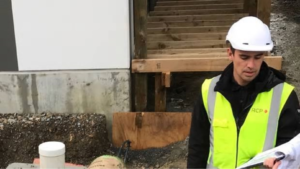24 Sep Whanganui’s Sarjeant: Matt Ritani looks forward to excavation and hopes of finding buried treasures
By Gaye Batty, Sarjeant Gallery Project Director.

Project manager for the Sarjeant Gallery redevelopment Matt Ritani.
Matt Ritani’s fascination with Whanganui’s Pukenamu Queen’s Park started as a young student focused on the site’s memorials.
Today Ritani (Ngāti Kahungunu, Ngāti Toa Rangatira, Irish) is a Pōneke/Wellington-based project manager for the redevelopment of the Sarjeant Gallery Te Whare o Rehua and is looking forward to excavation time. The Sarjeant Gallery at the top of Pukenamu Queen’s Park is currently closed for earthquake strengthening and construction of a new wing – Pataka o Sir Archie John Te Atawhai Taiaroa.
Matt’s relationship with Pukenamu Queen’s park dates back several years while studying for his Master of Architecture from Victoria University of Wellington. His design based project honed in on the site as one of the most memorialised sites in the country
“The site has a rich history of occupation representational of how many cities in New Zealand developed – it was originally a Māori pa site Pukenamu, then came colonial architecture such as Rutland Stockade, then institutional building like the Sarjeant Gallery. Pukenamu is a strong example of that pattern and development found all around the country.”
Coincidentally Ritani started his more recent research work on Pukenamu Queen’s Park before he took his current position with RCP, the project management firm chosen by Whanganui District Council for the Sarjeant Gallery’s redevelopment.
RCP was engaged in late 2017 as the design and project manager to procure the design consultants and manage the remainder of the design process through the tender process for selection and award of the main construction contract. Once the project moves into the excavation and construction phase, RCP will co-ordinate the information requests and often complex clarifications process between the main contractor and the design team. Ritani says one of the biggest challenges is seismic strengthening a historic building with intricate detailing on the inside and little space between the old stone exterior. “Our role is to take all the disparate priorities across the design team and facilitate that process. It’s fun working with these problems that are inter-disciplinary, navigating them in a balanced and collaborative way.”

Project manager for the Sarjeant Gallery redevelopment Matt Ritani.
Ritani’s more recent research on Pukenamu Queen’s Park looked at introduced technology in Pukenamu’s history from the initial harvest and use of riparian forest and raupo to the white Oamaru stone.
Mana whenua will use information from Matt’s research to contribute to the story and context informing the cultural impact assessment which will form part of the archaeological plan for submission to Heritage New Zealand Pouhere Taonga.
“Given the long occupation of the site we are likely to uncover some material that will provide us with more insight to the history of this place. It’s cool to be involved. It’s nice to see academic research brought together and used in such an important project.”
Click here to see the original article from the newzealandherald.co.nz

